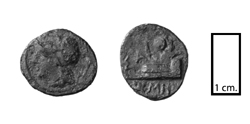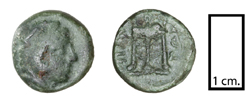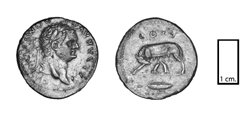Coins from the Eastern Hill
Nearly 1,000 legible coins, ranging in date from the late 6th century B.C. to the early 19th century, have been found during American excavations on Samothrace. As Laura Gadbery has noted, the fifty-seven Samothracian coins found during excavations on the Eastern Hill contribute to a more complete understanding of the local Samothracian mint and testify to activity on the island from the first half of the 4th century B.C. to the 17th century. Presented here are five of the more legible coins from the local mint including examples of the more common coin types found on the Eastern Hill.
Local Samothracian Coins
Prow Reverse Type
Bronze, 1.24g
NW Quadrant, over to ca. 2 m south of the south foundation of the Dedication of Philip III and Alexander VI
66.690

On its obverse this series features the head of the goddess Athena wearing a Corinthian helmet. A nude warrior crouching forward on the prow of a ship and holding a spear and shield is represented on the reverse. The Greek letters ΣΑ on the reverse indicate that the coin is local Samothracian issue. This coin series may have been introduced when the Samothracian mint reopened in the late 4th century B.C. after a prolonged hiatus. Other examples of the prow series have been found in contexts associated with theRotunda of Arsinoe.
The representation of a warrior on a ship’s prow may have commemorated a specific naval victory or it may have alluded to the power of the Great Gods to rescue sailors in peril at sea. Diodorus recounts that when the Argonauts came upon a great storm Orpheus, one of the crew members and an initiate into the Samothracian mysteries, prayed to the deities of Samothrace for their salvation. Next the wind died down, two stars fell over the heads of the Dioscuroi, and the whole company was amazed at the marvel which had taken place and concluded that they had been rescued from their perils by an act of providence of the gods (Diodorus 4.43.1-2).
Ram’s Head Reverse Type
Bronze, 1.66g
Northwest Quadrant, over to ca. 2m south of the south foundation of the Dedication of Philip III and Alexander VI
66.697 Prominently featuring a ram’s head facing a kerykeion on its reverse, like the prow type this series bears a head of the goddess Athena wearing a Corinthian helmet on its obverse. The letters ΣAMO on the reverse attests to the magistrate in office in the Samothracian polis at the time of the coin issue.
Prominently featuring a ram’s head facing a kerykeion on its reverse, like the prow type this series bears a head of the goddess Athena wearing a Corinthian helmet on its obverse. The letters ΣAMO on the reverse attests to the magistrate in office in the Samothracian polis at the time of the coin issue.
Kerykeion is the Greek word for caduceus, a short herald’s staff with two snakes entwined in the shape of a double helix. Commonly associated with the Greek Olympian god Hermes, in the context of the Sanctuary the ram and kerykeion were more likely linked to a god similar to Hermes who was worshiped in the cult of the Great Gods. In some cases ancient sources equated Hermes with Kasmilos (also spelled Kadmillo and Kamillos). These sources include Kasmilos among the great gods of Samothrace. According to this tradition Kasmilos was an attendant god to three other gods: Axieros, Axiokersas, and Axiokera. Hippolytus recognized the similar ithyphallic statues of Hermes on Cyllene in the ithyphallic statues of nude, youthful men flanking the doorway to the Anaktoron in the Sanctuary. He believed that the Samothracian images represented primal man and the regenerative spirit in every man (Hippolytus, Refutatio omnium haeresium 5.8.9-10). Among other instances, a kerykeion is represented on a bilingual inscription found outside the Anaktoron that prohibits the uninitiated from entering.
Half-ram Reverse Type
Bronze, 1.92g
SW Quadrant, cleaning the top step of the Theatral Circle
66.601 The half-ram reverse type is much rarer than the prow reverse or ram’s head reverse types. In this series the reverse bears the upper body, front legs, and head of a ram alongside the letters ΣΑΜΟ, indicating a Samothracian issue. Laura Gadbery has observed that the earliest dating evidence for the half-ram type on Samothrace comes from the construction fill of the Stoa, which has been dated in the second quarter of the 3rd century B.C. Although lacking the kerykeion, it is possible that the half-ram types were iconographically related to the ram’s head type.
The half-ram reverse type is much rarer than the prow reverse or ram’s head reverse types. In this series the reverse bears the upper body, front legs, and head of a ram alongside the letters ΣΑΜΟ, indicating a Samothracian issue. Laura Gadbery has observed that the earliest dating evidence for the half-ram type on Samothrace comes from the construction fill of the Stoa, which has been dated in the second quarter of the 3rd century B.C. Although lacking the kerykeion, it is possible that the half-ram types were iconographically related to the ram’s head type.
Seated Goddess Type (Head of Athena on obverse)
Bronze, 8.02g
NW Quadrant, around northeast corner of Dedication of Philip III and Alexander VI
65.1100 Because of its wide distribution – this coin type has been found as far afield as Thasos, Athens, Babylon, and along the Thracian coast – the seated goddess type is the best know of the Samothracian issues. Based on the Samothracian evidence and coins found in other parts of the Greek world Laura Gadbery has argued for a 2nd century B.C. date for the seated goddess type. The Samothracian magistrate at the time of issue was ΑΡΙΣTΟΞE.
Because of its wide distribution – this coin type has been found as far afield as Thasos, Athens, Babylon, and along the Thracian coast – the seated goddess type is the best know of the Samothracian issues. Based on the Samothracian evidence and coins found in other parts of the Greek world Laura Gadbery has argued for a 2nd century B.C. date for the seated goddess type. The Samothracian magistrate at the time of issue was ΑΡΙΣTΟΞE.
On the reverse is a goddess, seated on a throne or stool, wearing a belted chiton, himation around the waist, and a tall polos, or cylindrical crown. In her left hand the goddess holds a scepter and in her right hand a patera, a ritual vessel for pouring libations. On this particular coin a lion is poised beneath the stool. Although some scholars have identified the goddess as the Anatolian mother-goddess Kybele, it is more likely one of the goddesses worshipped in the Sanctuary. In particular, a goddess known as the Great Mother may have been worshiped locally as Axieros.
Seated Goddess Type (Bust of Athena on obverse)
Bronze, 6.69g
SW Quadrant, on or near packing between Monument Platforms and Stepped Retaining Wall
66.182

The seated goddess type continued to be issued into the Roman period but with a substantial change to the obverse. Rather than a head of Athena, the obverse bears a bust of Athena in three-quarters view with an eight-rayed star on a globe. Visible attributes of Athena are her peplos, aegis, and Corinthian helmet. As an exceedingly rare type, only eight examples have been found in American excavations on Samothrace, this coin may bear witness to the last productions of the Samothracian mint in the second half of the 1st century or the early 2nd century B.C.
Non-Samothracian Coins
The twenty-two non-Samothracian coins from the area of the Eastern Hill range in date from the first half of the 4th century B.C. to the 15th century. Of these three are from Macedonia, two are from Thrace, two from Chersonesos Taurica, and one from each of Thessaly, Euboia, and Saray in Turkey. Nine of the coins are from an indeterminable Greek mint. One coin is Ottoman. Finally, one coin is a Roman issue and one is from an unknown Roman provincial mint. Here is presented a representative selection of the more legible coins. The variety of foreign coins attests to only a fraction of the locations from which religious officials and initiates came to Samothrace. These locations may be added to what is known from the abundant initiate and theoroi lists that have been found in and around the Sanctuary.
Philippoi, Macedonia
356 – 345 B.C.
Bronze, 1.69g
Surface, over Theatral Complex
76.002
 On the obverse is a beardless head of Herakles distinguished by his lion’s skin. On the reverse is a tripod beside the letters ΦΙΛ[ΙΠ] and ΠΩΝ (Philippon).
On the obverse is a beardless head of Herakles distinguished by his lion’s skin. On the reverse is a tripod beside the letters ΦΙΛ[ΙΠ] and ΠΩΝ (Philippon).
Thessalonike, Macedonia
187 – 31 B.C.
Bronze, 6.81g
NE quadrant, on or near floor of Theatral Circle
66.681
 A bearded and laureate head of Zeus is visible on the obverse. On the reverse is depicted two goats confronting each other and standing on their hind legs. The letters Θ / Ε; Σ/ ΑΛ/[Ο] (Thesalo) designate the mint.
A bearded and laureate head of Zeus is visible on the obverse. On the reverse is depicted two goats confronting each other and standing on their hind legs. The letters Θ / Ε; Σ/ ΑΛ/[Ο] (Thesalo) designate the mint.
Lysimachos of Thrace
306/05 – 301/00 B.C.
Bronze, 5.39g
SE quadrant, over Theatral Complex
64.862
 A representation of Apollo with short hair and a laurel wreath is on the obverse. On the reverse is a young nude male rider on a galloping horse. Carmen Arnold Biucchi has observed that the somewhat corroded letters under the horse may be ΛΥ. If so, she attributes this coin to Lysimachos, king of Thrace, and dates it to 306-361 B.C., the years following his assumption of the title basileus.
A representation of Apollo with short hair and a laurel wreath is on the obverse. On the reverse is a young nude male rider on a galloping horse. Carmen Arnold Biucchi has observed that the somewhat corroded letters under the horse may be ΛΥ. If so, she attributes this coin to Lysimachos, king of Thrace, and dates it to 306-361 B.C., the years following his assumption of the title basileus.
Ainos, Thrace
405 – 350 B.C.
Bronze, 1.04g
SW quadrant, over or behind Stepped Retaining Wall
67.1262

The iconography on the two side of this coin from Ainos, Thrace are iconographically closely related. On the obverse is a head of the Olympian god Hermes. Hermes wears a close-fitting petasos, a Greek traveling hat that is one of his attributes. On the reverse the letters Α Ι /Ν Ι appear on either side of a kerykeion, the herald’s staff associated with Hermes.
Rome
A.D. 77-78 (COS V)
Bronze, 2.53g
Sacred Way, toward center of Sanctuary.
67.1256 
On the obverse of this Roman coin is the head of the Flavian emperor Domitian adorned with a laurel wreath. On the reverse is the Roman she-wolf with the twins Romulus and Remus. This well-known symbol evoked the legendary story of the founding of Rome involving Romulus and Remus, offspring of Mars, the god of war, and Rhea Silvia.
